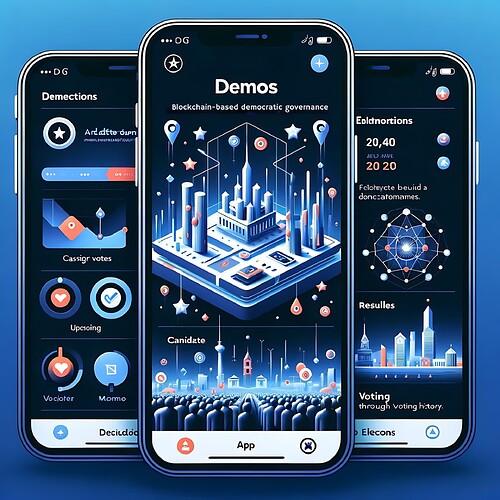Title: Introducing DEMOS: Revolutionizing Democratic Governance for Aradsterdam Elections
Introduction:
Welcome, everyone, to the presentation of DEMOS, an innovative application designed to transform the landscape of democratic governance in Aradsterdam. DEMOS stands for Decentralized Election Management and Oversight System, and it’s poised to revolutionize how elections are conducted and managed in our city.
What is DEMOS?
DEMOS is an application built on blockchain technology, serving as the backbone of the Aradsterdam Decentralized Autonomous Organization (DAO). It integrates Augmented Reality (AR) to enhance accessibility and transparency in the electoral process.
Key Features:
-
Blockchain-Based Security: DEMOS utilizes blockchain technology to ensure the integrity and security of the electoral process. Each vote is securely recorded on the blockchain, making it tamper-proof and resistant to fraud.
-
Decentralized Governance: Through the Aradsterdam DAO, DEMOS enables decentralized decision-making, allowing citizens to actively participate in shaping the future of our city. This ensures greater inclusivity and transparency in governance.
-
Augmented Reality (AR) Integration: By incorporating AR technology, DEMOS provides an immersive voting experience. Citizens can use their smartphones to access virtual polling stations and cast their votes from anywhere, at any time, making the electoral process more convenient and accessible to all.
-
Transparency and Auditability: Every step of the electoral process, from voter registration to vote counting, is transparent and auditable. Citizens can track their votes on the blockchain in real-time, ensuring accountability and trust in the system.
Benefits of DEMOS:
-
Enhanced Security: With blockchain technology, DEMOS ensures the security and integrity of the electoral process, eliminating the risk of tampering or manipulation.
-
Increased Participation: By leveraging AR technology, DEMOS makes voting more convenient and accessible, encouraging higher voter turnout and participation in elections.
-
Greater Transparency: Through its transparent and auditable nature, DEMOS fosters trust between citizens and the government, ensuring that elections are conducted fairly and accurately.
-
Empowering Citizens: The decentralized governance model of DEMOS empowers citizens to actively engage in decision-making processes, promoting a more inclusive and democratic society.
-
Cost-Efficiency: By streamlining the electoral process and reducing the need for physical infrastructure, DEMOS offers a cost-effective solution for conducting elections, saving both time and resources.
Conclusion:
In conclusion, DEMOS represents a significant leap forward in the realm of democratic governance. By harnessing the power of blockchain and AR technology, DEMOS empowers citizens, enhances security, and fosters transparency in the electoral process. Together, let’s embrace this revolutionary platform and shape the future of Aradsterdam through decentralized democracy. Thank you.
